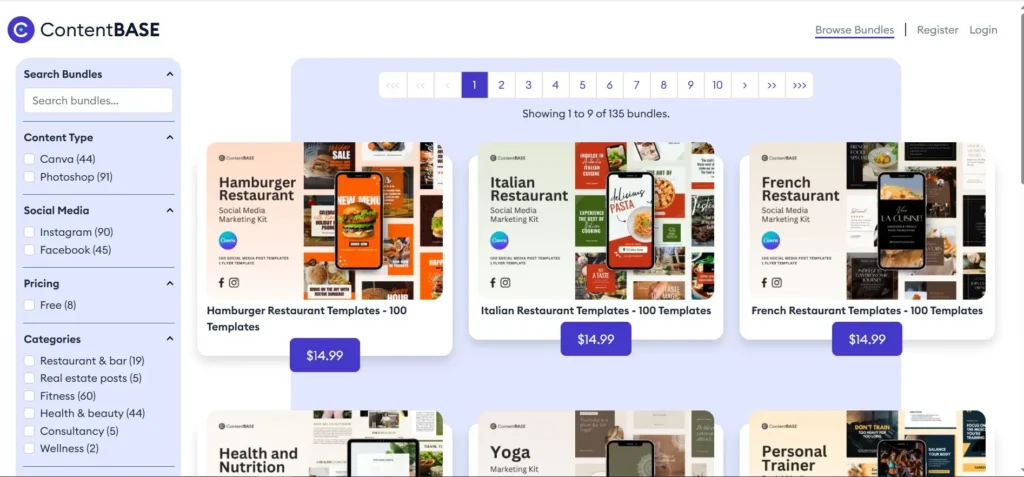Introduction
In the fast-paced world of digital marketing and content creation, having the right tools is not just a luxury—it’s a necessity. Teams today are expected to collaborate across time zones, maintain editorial calendars, ensure brand consistency, and produce content that resonates with audiences—doing all of that with spreadsheets, email threads, and disconnected project management tools? That’s a productivity nightmare waiting to happen.
This is where Contentbase steps into the spotlight. Marketed as an all-in-one solution for content teams, Contentbase promises to streamline your entire content workflow—from ideation to publishing. But does it deliver on that promise, or is it just another flashy tool in an already saturated market? In this in-depth review, we’re going to take you behind the scenes and explore whether Contentbase truly deserves a place in your team’s tech stack.
If you’re a content manager, digital marketer, editor, or part of a remote creative team looking to up your game, you’ll want to stick around. We’ll break down the features, usability, pricing, pros and cons, and how it stacks up against popular alternatives. Ready? Let’s dive in.

🔥 Ready to take your content workflow to the next level? Try Contentbase today and experience the platform built specifically for content creators and teams. Streamline your strategy, boost collaboration, and never miss a deadline again!
First Impressions of Contentbase
User Interface and Onboarding
The first thing that grabs your attention when logging into Contentbase is how clean and well-organized the interface is. There’s a minimalistic vibe that doesn’t compromise on power. The dashboard isn’t cluttered with a hundred widgets—you get only what you need, and everything is customizable. From color-coded content stages to drag-and-drop calendar views, Contentbase was designed with user experience in mind.
Onboarding is another area where Contentbase shines. Within minutes of signing up, you’re greeted with a guided setup wizard that walks you through creating your first workspace, assigning team members, and even setting up your editorial workflow. There are helpful tooltips and sample templates that make it easy to get up and running, even if you’ve never used a content platform before. This is especially important for teams with members who may not be tech-savvy.
Whether you’re a solo creator or managing a team of 20, the onboarding process scales to your needs. The platform’s intuitive design makes it easy to adapt without a steep learning curve. And for those who do need a little extra help, Contentbase offers excellent tutorial videos and a responsive support team ready to answer any questions.
Target Audience
Contentbase is not trying to be everything for everyone, and that’s a good thing. The platform is laser-focused on solving the specific problems content teams face. It’s built for marketers, content strategists, editors, writers, and anyone who plays a role in the content lifecycle. If you work in-house for a brand, run a content agency, or manage a freelance writing team, Contentbase has tools designed with you in mind.
That said, it’s not just for big teams. Solo content creators and freelancers will also find value here, especially in organizing content across multiple clients or channels. The ability to separate projects, create reusable templates, and track deadlines all in one place is a game-changer, even for one-person operations.
In essence, whether you’re publishing 3 blog posts a month or 300, Contentbase is built to scale with your team’s content ambitions. The platform caters to both structure-hungry agencies and flexible freelancers, all under the same clean umbrella.
Key Features of Contentbase
Centralized Content Planning
One of the core strengths of Contentbase is its centralized planning feature. Imagine having all your ideas, campaigns, blog posts, and social media strategies neatly organized in one place—no more jumping between Google Sheets, Trello, or random sticky notes. The platform allows you to build an entire content strategy with topics, target keywords, publishing dates, and assigned contributors in a single dashboard.
Each content item can be tagged, categorized, and linked to related assets like briefs, documents, or design files. You can even create custom content types, which is super useful if your team produces a variety of formats like podcasts, webinars, videos, or newsletters alongside traditional blog posts. This level of customization helps content managers maintain consistency across channels while ensuring everyone on the team understands the bigger picture.

Contentbase also supports advanced filtering and sorting features so that you can drill down into specific content types, status updates, assigned team members, or publishing dates. Whether you want to view all draft blog posts due next week or see which team members are overloaded, this tool gives you the visibility to make smart editorial decisions.
Real-Time Collaboration
Gone are the days of endless email threads and confusion over the “latest version” of a document. With Contentbase, your entire team can collaborate in real-time. Writers can draft content directly within the platform, editors can leave inline comments, and managers can track progress without ever needing to ask for status updates.
Every update is synced in real-time, so there’s no need to refresh or wonder if someone is viewing the old version. You can even set up approval stages, where pieces must be reviewed and signed off on before moving to the next phase. This eliminates bottlenecks and makes collaboration smooth, even across time zones.
Another bonus? You can attach reference links, upload media files, and integrate with tools like Grammarly and Google Docs. It’s a rich editing and feedback environment that keeps everyone on the same page—literally and figuratively.
Task and Workflow Management
Contentbase understands that content creation is a process, not a one-off event. That’s why it offers a robust task and workflow management system tailored to content teams. You can create templates for common workflows—like writing a blog post or producing a YouTube video—and assign tasks to specific people at each stage.
Workflows are fully customizable. Whether your process includes keyword research, drafting, SEO optimization, editing, approvals, or publication, Contentbase lets you define every step. Tasks can include due dates, checklists, file attachments, and comments to keep things moving smoothly.
What sets this apart is the visual workflow builder. Instead of just listing tasks in a to-do format, you can view them in Kanban, calendar, or list views. This makes it easy to manage large volumes of content without losing sight of priorities or deadlines.
Editorial Calendar Integration
The built-in editorial calendar is perhaps the beating heart of Contentbase. This is where strategy meets execution. With drag-and-drop functionality, you can rearrange content pieces, move deadlines, and quickly get a bird’s-eye view of what’s being published and when.
Each content item on the calendar is clickable, bringing up key details like the content type, the responsible team member, the status, and related tasks. You can also add color-coded labels to distinguish between content formats or campaigns, making it easy to scan for gaps or overlaps in your schedule visually.
Even better, the calendar integrates with tools like Google Calendar and Slack, so your entire team can stay updated without needing to log in constantly. This real-time visibility into the content pipeline is a massive boost for productivity and accountability.
Content Repository & Asset Management
Contentbase isn’t just about planning and scheduling—it’s also your central hub for storing and managing content assets. Whether it’s images, videos, brand guidelines, or past campaign documents, everything is organized in one searchable location.
The content repository allows you to create folders and subfolders, tag assets for easy filtering, and preview files without downloading. You can also attach assets directly to content items, so there’s no guesswork when it comes to finding the right header image or PDF attachment.
For larger teams, this feature dramatically reduces the time spent hunting for assets. For freelancers and solo creators, it means keeping your digital desk clean and clutter-free.
AI-Powered Suggestions and Templates
One of the most exciting additions to Contentbase is its AI-powered toolkit. The built-in AI can generate article outlines, rewrite headlines, suggest meta descriptions, or even help you brainstorm content ideas based on a target keyword or audience persona.

If you’re stuck staring at a blank page, the AI will nudge you in the right direction with proven frameworks and templates. Need a blog post structure for a product launch? Or social captions for Instagram? It’s all built in. And unlike some generic tools, these suggestions are relevant and actionable.
The AI doesn’t replace your creativity—it enhances it. Think of it as a helpful writing partner that gives you a head start without taking over your process. The best part? It’s integrated seamlessly into your existing workflow, so there’s no need to bounce between multiple tools.
💡 Already seeing the value? Start using Contentbase and supercharge your content operations.
Contentbase for Teams
Role Assignments and Permissions
Managing a content team often involves juggling different responsibilities, from writers and editors to designers and strategists. Contentbase simplifies this by letting you assign specific roles with clearly defined permissions. You can set who has the authority to create, edit, review, approve, or publish content, which eliminates the risks of accidental edits or unauthorized changes. This role-based structure adds an extra layer of control and accountability across the content lifecycle.
For larger teams, this becomes even more powerful. Team leads can create department-specific workspaces or channels within Contentbase, giving each group its area to work while still contributing to the broader content strategy. This segmentation ensures your social team isn’t buried in blog post discussions, and your writers aren’t distracted by design task notifications.
Plus, when onboarding new members, assigning roles helps them understand their responsibilities from day one. With predefined access levels, team members only see what they need to, keeping the interface clean and less overwhelming.
Communication and Comments
A major challenge in collaborative content production is maintaining clear communication. Contentbase bridges that gap with an integrated commenting and messaging system. You can comment on specific content tasks, tag team members, or start threaded discussions on drafts—all within the same platform.
This tight integration means no more switching to Slack or email to give feedback or ask questions. Every discussion stays attached to its corresponding content piece, so you never lose context. If an editor suggests a change, the writer sees it instantly and can act on it in real time.
Additionally, Contentbase supports @mentions and comment history, making it easy to track who said what and when. Whether you’re working asynchronously or in real time, this feature helps streamline communication, reduce miscommunication, and speed up revisions.
Multi-Channel Content Strategy Support
Today’s content isn’t limited to blogs. Content teams juggle blog posts, social media updates, videos, newsletters, podcasts, and more. Contentbase is built with this multi-channel reality in mind. You can create separate strategies and workflows for each channel, assign different team members, and track performance individually.
For example, your social media team can manage Instagram and LinkedIn content within their workflow while your blog team works on long-form posts with a separate approval system. Yet, everything still lives under the same roof. This allows for cross-channel coordination without clutter or confusion.
You can also align multi-channel campaigns by tagging related content and using dashboards to track how assets for each channel are progressing. This makes Contentbase an ideal choice for marketing departments that need to ensure brand consistency across every platform.
How Contentbase Improves Productivity
Reduces Silos
One of the biggest productivity killers in content teams is the silo effect—when information is trapped in different tools, teams, or minds. Contentbase addresses this by centralizing content planning, production, communication, and assets in a single platform. Everyone from strategists to copywriters to graphic designers works within the same ecosystem.
By breaking down silos, Contentbase encourages collaboration and transparency. Writers see what designers are working on. Editors understand campaign goals. Project managers can check in on progress without pestering the team. This shared visibility creates a more aligned and efficient workflow.
Additionally, shared access to calendars, briefs, and documents means fewer meetings and less back-and-forth. You get more time to create and less time coordinating logistics.
Speeds Up Approval Cycles
Delays in the approval process are the silent killer of many content teams’ productivity. Waiting days (or even weeks) for feedback or sign-off can derail your publishing schedule. Contentbase tackles this head-on by allowing you to create automated approval workflows that include stakeholders at each step.
For instance, once a writer submits a draft, it can automatically be routed to an editor, then to the content manager, and finally to a legal team for compliance checks if needed. Each person receives a notification and can view and comment directly in the system, cutting the time between draft and publish significantly.
This streamlined approach is constructive for agencies or regulated industries that need multiple layers of approval before content goes live. And because the system records all approvals and feedback, there’s never any confusion about who made what decision and when.
Keeps Everyone in Sync
With features like real-time updates, shared dashboards, and synced notifications, Contentbase ensures that no one on your team is ever out of the loop. Every change, comment, deadline, or new task is communicated clearly and automatically to those it concerns.
This is a huge win for remote teams or those working across different time zones. You don’t have to wait for someone to “come online” to get updates. Everything is logged and available in one place, reducing dependence on meetings or manual updates.
Weekly team syncs become more about strategy and less about status updates—because everyone already knows where things stand. And with integrations into tools like Slack and email, you’ll always get notified of the updates you care about, without being overwhelmed by irrelevant alerts.
Comparing Contentbase with Competitors
Contentbase vs Notion
Notion is an incredibly flexible workspace tool, great for note-taking and organizing content. However, when it comes to dedicated content production workflows, it falls short. Notion requires heavy customization to mimic editorial calendars or workflow automation, and even then, it doesn’t offer native content lifecycle tracking.
Contentbase, on the other hand, is purpose-built for content teams. You don’t need to create templates or hack together task lists. It comes with everything pre-structured—editorial calendar, collaboration tools, workflow builders, asset libraries, and even AI support. If you’re managing more than a few content pieces a week, Contentbase saves you time and reduces complexity.
Contentbase vs Trello
Trello is great for visual task management, especially if you’re managing simple projects or small content calendars. However, it lacks depth when it comes to content-specific features. There’s no built-in editorial calendar, approval flow, or centralized asset storage. You’ll need to add multiple power-ups (and often pay extra) to get the functionality Contentbase offers out of the box.
While Trello works well for light content planning, Contentbase is the better option for professional teams who need structure, visibility, and performance tracking built around a content-centric workflow.
Contentbase vs Airtable
Airtable offers a highly customizable spreadsheet-database hybrid that’s popular among tech-savvy teams. It can be adapted to run editorial workflows, but it often requires time-consuming setup and management. It’s not inherently built for content, so you’re forced to design your system from scratch or purchase expensive templates.
Contentbase offers a turnkey solution with much less setup. While Airtable is a powerhouse for data-driven teams, Contentbase wins on usability, speed, and being purpose-built for the content production process. If your focus is storytelling and marketing—not engineering workflows—Contentbase is a more practical fit.
Pricing Plans and Value for Money
Contentbase offers three main pricing tiers, each designed to cater to a different type of user: individuals, teams, and enterprises. The Free Plan is ideal for solo creators or freelancers just starting. It includes access to the editorial calendar, task management, and basic collaboration tools—more than enough for managing a few projects at a time.
The Team Plan, which includes additional integrations, advanced workflows, AI suggestions, and multi-project support, is perfect for marketing departments or agencies handling multiple campaigns. The price is competitive when you consider that it consolidates tools like Trello, Google Docs, Calendars, and Dropbox into a single platform.
For larger organizations, the Enterprise Plan includes custom roles, SSO support, dedicated onboarding, and priority support. It’s built to handle the complexity of multinational teams with dozens of contributors and multiple layers of approval.
When compared to other tools that require multiple subscriptions, Contentbase’s all-in-one approach delivers exceptional value for money. Plus, the generous free tier is a great way to test the platform before upgrading.
Pros and Cons of Contentbase
What We Love
One of the biggest strengths of Contentbase is how purpose-built it feels for content teams. Unlike generic project management tools that require tweaking and heavy customization, Contentbase works out of the box. The editorial calendar, workflow automations, content repository, and real-time collaboration features come pre-structured, which drastically reduces setup time and boosts usability.
The interface is sleek and modern—no clutter, no unnecessary bells and whistles. Everything feels where it should be. On top of that, the AI-assisted features are genuinely helpful rather than gimmicky. From content idea generation to headline optimization, the AI suggestions enhance creativity rather than replace it. For content teams looking for efficiency without sacrificing creativity, this is a huge plus.
Additionally, Contentbase is constantly evolving. The development team rolls out frequent updates, listens to user feedback, and expands integrations regularly. This adaptability ensures the platform stays current with industry trends and user needs, making it a solid long-term investment.
Where It Could Improve
While Contentbase checks a lot of boxes, no tool is perfect. One area where it could improve is in its third-party integration support. While it integrates with common tools like Google Drive, Slack, and Calendars, the platform still lacks deeper integrations with platforms like WordPress, HubSpot, or Canva. For teams managing web content or creatives in Canva, having seamless bridges would streamline workflows further.
Another point of consideration is the mobile experience. While Contentbase is responsive on mobile browsers, the dedicated mobile app is still under development. For content teams that need to work on the go or approve drafts via their phones, this could be a limitation, at least for now.
Lastly, for very small teams or solo freelancers, the sheer breadth of features might feel like overkill. Although the platform is easy to use, it may take time to fully appreciate and adopt all the features unless you have a well-defined content workflow in place.
Use Cases
Small Agencies
Small digital marketing or content agencies often juggle multiple clients, each with their tone, strategy, and calendar. Contentbase makes this juggling act far less chaotic. Agencies can set up separate workspaces for each client, with individualized workflows, deadlines, and permissions. The editorial calendar gives visibility across all accounts, so agency leads can spot bottlenecks or misalignments before they become problems.
It also helps with client communication. Instead of sending long update emails, agencies can give clients limited-access permissions to view or comment on projects in real time. This level of transparency builds trust and shortens the feedback cycle dramatically.
Large Content Teams
In-house content teams within enterprises often face challenges around communication, approval bottlenecks, and overlapping priorities. Contentbase solves these pain points by offering enterprise-grade permissions, layered approval workflows, and a centralized content hub that ensures everyone is on the same page.
Each department—whether it’s SEO, PR, or product marketing—can work within its workspace while still aligning with the broader brand strategy. Shared calendars and dashboards make cross-functional coordination far easier, and leadership gets real-time visibility into content performance and team output.
Freelancers Managing Multiple Clients
Freelancers are often left stitching together multiple platforms to manage client work—email for communication, Trello for tasks, Google Docs for drafts, and spreadsheets for schedules. Contentbase consolidates everything. Freelancers can organize client workspaces, store reusable templates, track deadlines, and manage revisions all in one place.
This not only helps freelancers appear more professional but also saves time and reduces errors. Clients are impressed by the organization and transparency, which often leads to longer-term engagements and referrals.
Real User Testimonials
“Contentbase has made our content process seamless. Before, we were juggling five tools and still missing deadlines. Now, we’re ahead of schedule and aligned as a team.”
— Rachel T., Marketing Director at SaaSify
“As a freelancer, I needed something that could keep my client projects organized without the overhead. Contentbase is like having a virtual assistant for my content work.”
— Marco B., Freelance Content Strategist
“We replaced Trello, Docs, and our editorial spreadsheet with Contentbase. It took some adjustment, but now we can’t imagine going back.”
— Janelle F., Head of Content at ThinkGrowth
Tips to Maximize Your Contentbase Experience
Custom Views
One of the lesser-known but powerful features in Contentbase is the ability to create custom views. Whether you want to see just social media tasks for the week or all draft blog posts in progress, you can build filtered dashboards that update in real-time. This gives every team member a personalized control panel.
Managers, for example, can view all content due this week by team member, while editors can focus only on content that’s ready for review. These views remove clutter and help each role focus on its specific responsibilities without distraction.
Integration Hacks
Even with limited third-party integrations, there are smart workarounds. For example, you can link your Google Drive folders directly to tasks or upload your editorial briefs as PDFs. Use Zapier to connect Contentbase to tools like Mailchimp, Airtable, or WordPress. It’s not as seamless as native integration, but it gets the job done and keeps your workflow centralized.
For Slack users, setting up real-time notifications through Contentbase can keep your team updated on task completions, new assignments, or deadline changes—all without needing to constantly log into the platform.
Automation Ideas
Set up automated task creation using templates. For example, when you create a new blog post, it can automatically generate tasks for keyword research, writing, editing, and publishing. Assign these tasks to the appropriate people, with auto-filled deadlines based on your content calendar. This keeps your content production running like a well-oiled machine.
Also, consider setting up automated check-ins or reminders for overdue content or unreviewed drafts. This small touch keeps your pipeline flowing without constant manual oversight.
Is Contentbase Secure and Reliable?
When working with collaborative tools, especially ones involving client information or marketing strategies, security isn’t optional—it’s critical. Contentbase takes data security seriously. All data is stored in encrypted servers using industry-standard protocols (AES-256), and the platform is GDPR compliant.
User activity is logged, and administrators can view access history, manage permissions, and revoke access immediately when someone leaves the team. This kind of control is invaluable for enterprise teams and agencies dealing with sensitive projects.
On the reliability side, Contentbase has a 99.9% uptime guarantee, with regular backups to ensure nothing gets lost in the event of an outage. The web app is fast, responsive, and rarely experiences downtime—an essential trait when your content pipeline depends on consistent performance.
While the mobile app is still in development, the web version is fully mobile responsive, so teams can check updates and leave feedback even while commuting or traveling.
Final Verdict: Should You Use Contentbase?
If you’re involved in content creation at any level—writer, editor, marketer, manager—Contentbase is one of the best investments you can make for your workflow. It’s more than just a content planner; it’s a centralized hub designed specifically for the realities of today’s content ecosystem.
From ideation to final publish, Contentbase covers the entire lifecycle. Its built-in collaboration tools, smart workflows, and editorial calendar mean fewer errors, fewer missed deadlines, and fewer headaches. And unlike generic tools that require constant modification, Contentbase feels like it was designed for content people, by content people.
There are a few limitations—like limited third-party integrations and a mobile app in development—but they’re far outweighed by the platform’s strengths. Whether you’re a solo content creator or managing a 20-person team, Contentbase gives you the structure and flexibility to scale.
In short, Contentbase isn’t just a content tool. It’s a game-changer for teams that take their content seriously.
🎯 Don’t just take our word for it—sign up for Contentbase today and see the results for yourself!
Conclusion
In a world overflowing with SaaS tools, Contentbase stands out by doing one thing exceptionally well: helping content teams plan, create, and publish better. It’s a sleek, powerful platform that reduces chaos, boosts collaboration, and centralizes everything you need to move fast without losing quality.
If you’re tired of duct-taping multiple tools together or losing productivity due to miscommunication and silos, Contentbase might be exactly what your team has been looking for. It’s smart, streamlined, and scalable—just what modern content teams need to thrive.
FAQs
1. Is Contentbase good for solo creators?
Yes! Solo creators can benefit greatly from the Free Plan. It keeps you organized, reduces tool overload, and lets you manage clients, deadlines, and assets from one platform.
2. Can I integrate Contentbase with Google Drive?
Absolutely. You can attach and manage files from Google Drive directly within tasks and content items for seamless collaboration.
3. Is Contentbase suitable for agencies?
Definitely. Agencies will love the ability to manage multiple clients, assign roles, streamline feedback, and track content across brands—all from one place.
4. How secure is my data on Contentbase?
Very secure. Contentbase uses encrypted storage, regular backups, access logs, and role-based permissions to protect your content and team data.
5. Does Contentbase offer mobile app support?
Currently, Contentbase is accessible via mobile browser with a fully responsive interface. A dedicated mobile app is in the works and expected soon.






